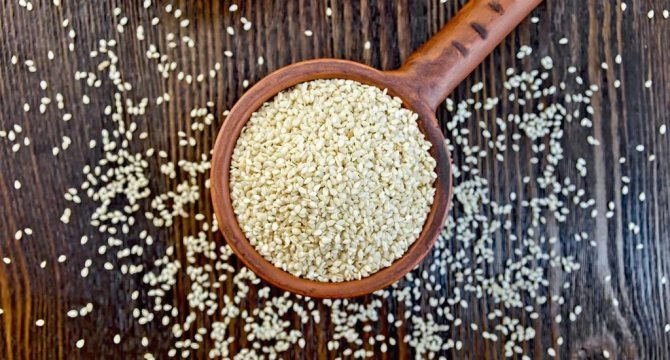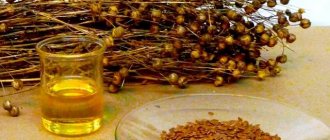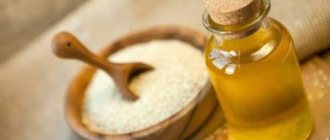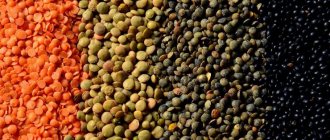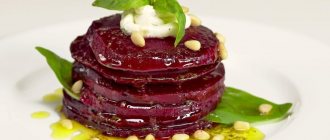Surely every person remembers the fairy tale about Ali Baba and his spell “Sim-sim open!” In some languages, this expression sounds slightly different: “Open sesame!” The botanical name for sesame is “sesame”. This is most likely due to the fact that as soon as the sesame seeds ripen, they immediately burst and make a sound very similar to a squeaking door opening.
| Calories per 100 g, (kcal): | 573 |
| Protein per 100 g, (g): | 45 |
| Fat per 100 g, (g): | 12 |
| Carbohydrates per 100 g, (g): | 32 |
| Glycemic index: | 35 |
Sesame seeds have been used by people for several hundred years. They are a real storehouse of calcium, which is responsible for the most important processes in the body.
Difference between black and white seeds
Sesame seeds come in a variety of colors: golden, white, reddish, black and brown. The main colors are white and black.
Black seeds grow in Thailand and China, black seeds grow in Guatemala, Mexico and El Salvador (the main supplier of seeds). In the Middle East and West, white seeds are more popular. Today there are 35 types of sesame.
Main differences:
- black seeds have a bitter taste, while white ones have a nutty taste;
- white seeds are used in sweet dishes, and black seeds produce excellent oil and are used to season main courses;
- black seeds have more iron than white seeds;
- black sesame has a strong aroma, white sesame has a less intense aroma;
- white seeds have higher levels of fat and protein;
- Black sesame has a higher antioxidant content.
It is important to know that after removing the seed coat, about 90% of the calcium remains in the seed coat. Therefore, it is recommended to consume unhulled seeds, regardless of color.
What is sesame
Sesame or sesame is a herbaceous plant from the Pedalaceae family, the main places of growth of which are India and Africa. The photo shows that tropical sesame has flowers in white and purple shades. The most valuable oil plant of the genus is Indian sesame, which has taken its place of honor in the culinary world. It is used to prepare kozinaki, toppings for baked goods, aromatic seasonings, sauces, and also tahini, a special paste known in Arab and Jewish cuisines.
Sesame seeds are used to make sesame oil, useful in the production of cosmetics and medicinal ointments. There are 2 varieties of sesame - white and black. The latter type is much more expensive and healthier, since unrefined black grains are not polished. Sesame seeds taste like nuts. Hulled sesame seeds can be used for 6 months if stored in the refrigerator, and if frozen, then for about a year. The shelf life of sesame oil is 10 years.
- Sinusitis - symptoms and treatment in adults. What antibiotics and folk remedies are taken for sinusitis?
- Antitussives for dry cough
- Recipes for cooking barley porridge in a slow cooker
Sesame - composition
The composition of sesame grains, in addition to minerals and vitamins, contains: water, proteins, fats, carbohydrates, dietary fiber (fiber), ash, antioxidants (sesaminol, sesamol). The vitamin complex includes beta-carotene (A), thiamine (B1), riboflavin (B2), niacin (PP), folic and pantothenic acids (B9 and B5), pyridoxine (B6), tocopherol and choline (E, B4). If we consider the mineral composition of sesame, then there are the following macro- and microelements:
- zinc;
- iron;
- selenium;
- copper;
- manganese;
- phosphorus;
- potassium;
- sodium;
- magnesium;
- calcium.
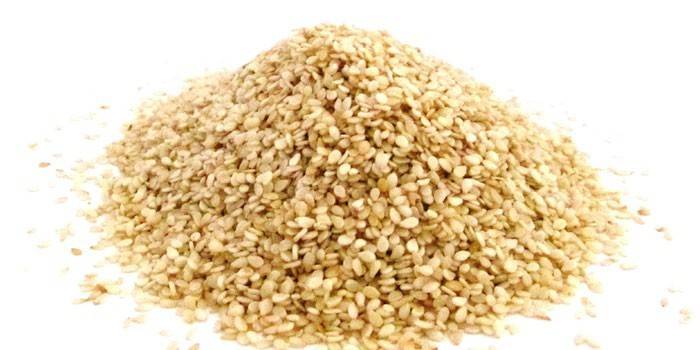
Sesame seed calories
Sesame seeds are high in calories because more than half of them are fat. The average calorie content of sesame seeds per 100 grams is about 570 calories. What are the benefits of sesame seeds? They are rich in calcium. A unique fact is that 100 grams of sesame can fill the body’s daily need for a particularly important macronutrient. Calcium from sesame is better absorbed than milk.
Sesame beneficial properties
In most cases, the seeds are used as a seasoning. In the old days, sesame was used for medicinal purposes. Even Avicenna used it and believed that the seeds contributed to the resorption of tumors. To get rid of belching, he made decoctions. He also made dressings with rose oil and sesame oil to help the patient get rid of headaches.
It is not known how much Avicenna helped his patients with sesame seeds, but it is known for sure that these are very valuable seeds, with a wide range of useful substances and vitamins.
How to eat sesame
Sesame can be used in different ways. The use of sesame oil is common in cooking. Various dishes are prepared on it, which increases their beneficial effect on the body.
The seeds are taken for medicinal purposes: they can be slightly heated, brewed with water or consumed raw.
To prepare medicinal products, the seeds are ground in a coffee grinder and then mixed with additional ingredients. They are also often used as a seasoning for salads, rice, cookies and other baked goods.
Grain-based tahini paste is especially popular in Eastern countries; it is beneficial when consumed systematically in moderation as a means of improving overall well-being.
To lower blood pressure and cholesterol
To prevent high cholesterol levels in the blood, it is recommended to take cold-pressed sesame oil; it normalizes blood pressure. 1 tsp. drink 3 times daily.
A mixture of sesame oil and honey has medicinal properties: the benefits of such a remedy lie in normalizing blood flow and improving the condition of blood vessels. 1 tbsp. l. The mixtures are taken daily for a month.
How to eat sesame for better calcium absorption
To increase the effect of beneficial properties, it is recommended to soak the seeds for 5 - 6 hours. This method improves the absorption of calcium by the body. Grains take 1 tsp. daily.
How many sesame seeds can you eat per day?
The benefits of taking roasted or raw sesame can exceed the harm indicators only if all the rules for its daily consumption are followed.
We recommend reading: What are the benefits of citric acid, how to make it at home
The norm for semen consumption for an adult is 100 - 150 g daily.
The use of sesame in cosmetology
The beneficial properties of sesame for women have been used in home cosmetology; masks for hair and face are prepared on its basis. Most often, sesame oil is used to prepare products because it has unique beneficial properties:
- Helps moisturize dry, damaged skin;
- activates regeneration processes.
The benefits of sesame flour in cosmetology are also high. The seeds are ground using a coffee grinder, and additional ingredients are added to the flour. They can be: honey, essential oils, herbal plant extracts, various extracts.
How to use sesame in cooking
Sesame seeds are known to chefs as a valuable seasoning. Arabic dishes are traditionally prepared with sesame. It is used to make tahini, hummus, and chickpeas. These are colorful traditional dishes where sesame is one of the main ingredients.
In Europe, baked goods are common, which are sprinkled with seeds at the last stage of heat treatment.
Sesame is used as a finishing element for preparing various vegetable and meat salads. Seeds significantly improve the taste and appearance of dishes.
Interesting! Both white and black sesame are used to decorate baked goods: the latter is an unpeeled version with a crispy shell and a pronounced nutty taste, containing antioxidants, calcium, zinc and B vitamins in higher concentrations than the white variety.
Cookies are traditionally made from sesame flour, and halva is made from sesame paste. These desserts are especially loved by residents of Middle Eastern countries.
Benefits and uses of sesame milk
Sesame milk is used as a means to increase calcium reserves in the body. It has particular benefits for infants. If it is impossible to digest cow protein with sesame seeds, prepare coconut or soy milk. This product enriches the body with nutrients, replenishes calcium deficiency and increases the body’s immune strength.
To prepare sesame milk take:
- 100 g seeds;
- 1 liter of liquid (water or milk).
The grains are soaked for 5 - 6 hours. The water is drained, the seeds are poured with the prepared liquid, then blended with a blender and a sweetener is added. The resulting drink is filtered. To improve the taste, use berries, fruits, and cinnamon. This mixture can be stored for no more than a day.
What are the benefits of sesame for women?
The level of female hormones directly affects the well-being of the fair half of humanity.
Sesame seeds contain Omega-3, which regulates hormonal balance and even affects the success of conceiving a baby. Estrogen contained in sesame affects breast growth. And to get rid of unpleasant sensations during PMS, you should eat sesame seeds. They help cope with swelling, nervousness and drowsiness, and even “dull” the heightened feeling of hunger.
During menopause, it is also recommended to consume sesame seeds. They help reduce the number of hot flashes and even improve sleep.
Benefits of sesame for men
For men, sesame seeds are a real godsend. After all, sesame has a positive effect on potency. Even our ancestors knew about this and were sure to add sesame to all means that helped increase libido. This is due to a large amount of vitamin E, which prolongs sexual activity and is also called the vitamin of youth.
To increase potency, you can simply consume sesame seeds on a regular basis. To improve the effect, it is better to mix the seeds with honey. And if a wife wants to have a good night with her husband, then in the evening it is recommended to feed her husband halva with sesame seeds and honey.
Three types of seeds can be mixed as an aphrodisiac: sesame, poppy and flax.
How to use
You already know how sesame seeds are beneficial for the body - it’s time to figure out where small grains are added. There can be many ways to use it:
- As a seasoning for salad or hot dishes;
- As an additive to baked goods;
- For preparing decoctions and infusions;
- For squeezing oil - it is used in the food industry and cosmetic purposes.

As you can see, there are many answers to the question of how to use sesame seeds.
Let's give some useful advice if you want to use the seeds for health - do not fry the sesame, as after heat treatment all the available benefits are gone.
Now let's talk about how to use sesame seeds to absorb calcium.
For calcium absorption
Sesame holds the record among other seeds for calcium content. In order to preserve all the beneficial qualities, it is necessary to follow certain rules for taking raw sesame seeds - the absorption of calcium is a very complex process that is influenced by a lot of factors. We recommend following our tips:
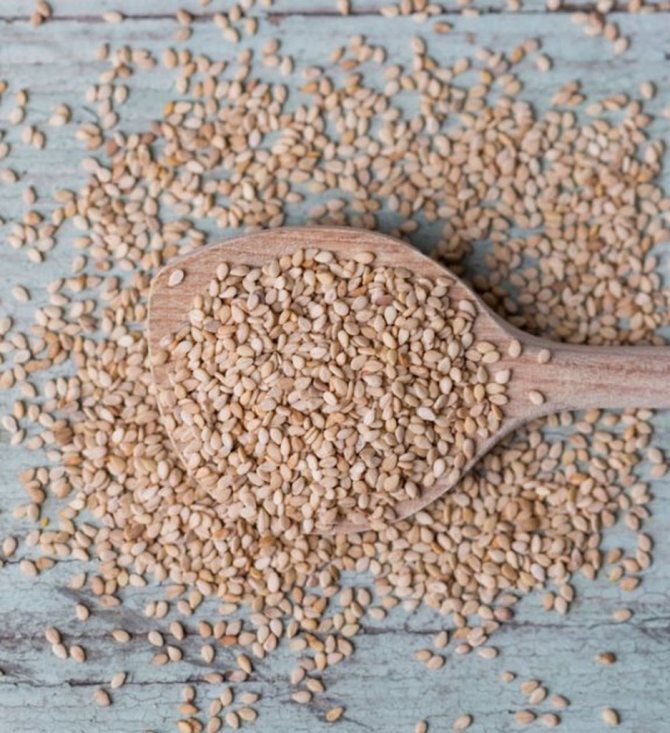
Store the grains for no more than six months in a dark, closed and cool place;- Provide your body with enough vitamin D;
- Combine spice with phosphorus - it is found in fish, herbs, cottage cheese;
- Monitor the level of stomach acidity and avoid acid imbalance;
- Strictly control physical activity. You shouldn’t give up physical education, but exercise should be moderate;
- You should not take foods that remove useful minerals - coffee, salt, carbonated drinks, spinach and sorrel.
We also recommend: Flax seed for women
The identified beneficial properties and contraindications of sesame seeds are a consequence of the chemical composition of the product. Got it? It's time to move on - let's discuss what benefits and harms sesame seeds contain for women.
Sesame seed during pregnancy and lactation
First of all, the seeds are recommended to be consumed during the period when pregnancy is planned. During this period, you should consume 1-2 tablespoons of seeds.
When a woman becomes pregnant, sesame is beneficial due to the presence of folic acid, which prevents the development of a neural tube defect in the unborn child. And the iron contained in the seeds helps prevent anemia. Calcium, which is also abundant in the seeds, is involved in the formation of the baby’s skeleton and protects the teeth of the expectant mother.
In addition, a pregnant woman with the help of sesame can get rid of the following conditions characteristic of the period of gestation:
- eliminating constipation;
- strengthening nerves;
- enriching the body with vitamins;
- stabilization of the urination process.
Although there are some restrictions. In the first trimester, you should limit the consumption of seeds, as they can cause a miscarriage.
During lactation, the seeds stimulate the production of milk, which is enriched with calcium. And this is very important for the baby.
Benefits of sesame seeds
Sesame seeds have a number of medicinal properties. They owe this to the unique composition of substances that nature gave them.
- The presence of calcium in the composition makes sesame useful for normalizing the formation of musculoskeletal tissue. Calcium is needed by the body for natural growth and development.
- Vitamins and natural antioxidants help improve the appearance of hair, nails, and skin.
- Phytoestrogens, which are considered analogues of female hormones, in sesame are beneficial as activators of reproductive function for women. In addition, they have properties to prevent the development of cancer.
- The plant contains two compounds - sesamin and sesamolin, which are water-soluble antioxidants that effectively prevent aging and the development of cancer.
- These unique substances in sesame also help normalize blood circulation throughout the body and prevent the development of atherosclerotic plaques. This benefits people suffering from disorders of the cardiovascular system.
- Vitamins and microelements contribute to the natural growth and normalization of the functioning of all organs.
Interesting! The famous eastern healer Avicenna spoke about the value of sesame seeds as an excellent cleanser for the intestines. In ancient times, dry coughs, constipation and anemia were treated with seasoning grains.
What are the benefits of sesame for women?
The benefits of sesame for women lie not only in normalizing reproductive activity, but also in helping to improve hormonal levels. Essential oils have an impact on women's psycho-emotional states during difficult periods of life.
We recommend reading: What are the benefits of Borodino bread?
Sesame seeds for men
Sesame seeds are a natural aphrodisiac, which makes them attractive to men. Phytosterols help normalize the functioning of the reproductive system.
Regular consumption of seeds as part of complex products has a strengthening effect on the heart muscle and helps restore strength after intense physical exertion.
Benefits of sesame for older people
The benefits and harms of sesame for the health of an elderly person can be discussed from the point of view of moderate consumption and taking into account physical condition.
The particular benefit of white sesame for people over 50 years old is that it is a source of digestible calcium. At this age, calcium is necessary for the prevention of diseases of the musculoskeletal system. In addition, doctors talk about the beneficial properties of grains that contribute to:
- prevention of osteoporosis;
- age-related changes;
- preventing the development of cancer;
- a positive effect on brain activity and, as a result, the prevention of Alzheimer's disease.
Is it possible to eat sesame for pregnant and lactating women?
The centuries-old experience of traditional medicine claims that sesame tends to harm the intrauterine development of a child during pregnancy. Despite the high content of calcium, copper and fatty acids, consuming sesame seeds during pregnancy can cause an increase in uterine tone.
The benefits of sesame seeds for pregnant women can only be discussed if the woman has no problems with pregnancy and consumes the seeds occasionally.
In order not to harm the development of the baby, as well as to avoid an allergic reaction, sesame should not be consumed during the first three months of pregnancy.
During the lactation period, sesame seeds:
- have a beneficial effect on milk production;
- help improve its taste;
- increase fat content.
In addition, the properties of the seeds to prevent the development of mastopathy are beneficial. The calcium in sesame is beneficial for both the young mother and the baby.
At what age can children be given sesame?
Sesame seeds for children have particular benefits as part of sesame milk. It is offered to children starting from 1 year. The only obstacle that can harm the baby’s health is the development of an allergic reaction.
Before introducing sesame milk into your diet, you should seek the opinion of a pediatrician. In the absence of allergic reactions to sesame milk, it is recommended to prepare porridge and other dairy dishes.
Warning! Grains, sweets or paste with sesame begin to be given to children only after 3 - 4 years.
The benefits of sesame for weight loss
Modern nutritionists argue about the benefits or harms of sesame seeds for weight loss. The harm to seeds is considered from the point of view of the increased oil content and high calorie content of the product.
The benefits of sesame for weight loss, according to sports nutritionists, lie in its antioxidant properties. In addition, plant fiber improves metabolic processes. Improving metabolism during a diet is considered one of the most important necessary points.
Advice! It is recommended to combine sesame seeds with green vegetables and fruits.
Sesame seeds for children
Sesame is good for children. The main thing is not to exceed the dose, otherwise they will cause weight gain and may cause bowel problems. It is not recommended to give seeds to children before 3 years of age and no more than 7 g per day. You should not give fried seeds to children; they have virtually no benefits for the body.
When starting complementary feeding, sesame milk can be given. You can cook it yourself. For 150 ml of boiling water you will need 20 g of sesame seeds, leave the tincture for the whole night. In the morning, the swollen seeds are ground or crushed in a blender and filtered. You can cook porridge with this mixture. You should not give sesame milk before the age of 1 year, there is a risk of developing an allergic reaction.
The benefits of sesame for children are obvious; it helps strengthen teeth, support bone growth and protect them from fragility.
Recipes
No matter how healthy sesame seeds are considered, in most cases they remain an additive to main dishes. They complement them perfectly, highlighting them with a pleasant nutty aroma. You can taste their taste in sesame halva, rolls and other products.
Crispy shortbread cookies with sesame seeds
| Sesame seed | 160 g |
| Wheat flour | 60 g |
| Sugar | 120 g |
| Chicken egg | 1 PC. |
| Butter | 65 g |
| Salt | 0.3 tsp. |
| Vanilla sugar | 1 sachet |
| Apple vinegar | 1 tsp. |
| Baking powder | 1 tsp. |
Preparation:
- Prepare all the necessary ingredients.
- In a bowl, mix softened butter and sugar.
- Add vanilla sugar. Grind until smooth.
- Beat in the egg, stir.
- Add apple cider vinegar. Can be replaced with lemon juice.
- In a separate container, combine the dry ingredients: flour with baking powder and salt.
- Add the dry mixture to the liquid mixture and mix thoroughly.
- Add sesame seeds. Knead the dough.
- Using a teaspoon, drop balls of dough onto the parchment. You need to leave a distance between them; during baking, the balls spread apart.
- Bake at 180 degrees for 10-15 minutes. Once the color turns golden, you can remove the cookies from the oven.
- Let the baked goods cool directly on the parchment. The soft structure becomes loose and crispy as it cools.
Rice with lime and sesame
| Rice (Mistral, Basmati) | 1 glass |
| Lime zest | 1 PC. |
| Lime juice | 1 tbsp. l. |
| White sesame seeds | 1 tbsp. l. |
| Black sesame seeds | 1 tsp. |
| Salt | taste |
| Vegetable oil | 1 tbsp. l. |
Preparation:
- Boil rice in salted water.
- Place the porridge in a bowl.
- In a frying pan without oil, fry the sesame seeds for 2-3 minutes. You should stir them constantly to prevent them from burning.
- Add lime zest and juice to bowl with rice.
- Pour sesame seeds from the frying pan into the rice, add vegetable oil. After mixing, you can serve.
Sesame milk
- wash and dry sesame seeds (100 g);
- grind them in a blender (no need to soak them first);
- pour the powder from the blender bowl into a container with a volume of at least 1.5 liters;
- add water (800-1000 ml);
- leave the mixture covered for several hours;
- Using an immersion blender, beat the soaked sesame seeds again (along with water);
- strain the resulting liquid.
The healing drink is ready!
Harm of sesame
First of all, it is not recommended to use sesame if you have diarrhea, as the condition will only worsen.
If you are prone to obesity, the seeds are contraindicated, as they are very high in calories. Pregnant women should not consume sesame if they have problems with blood clotting. It is unacceptable to consume seeds if you have kidney stones or high stomach acidity. You should not get carried away with sesame if you have varicose veins.
Under no circumstances should you eat sesame seeds in their pure form on an empty stomach. This is followed by severe thirst or nausea. Sesame can cause kidney stones if consumed with oxalic acid, which is found in cucumbers, tomatoes and spinach. You cannot combine taking aspirin and sesame.
The benefits and harms of seeds
Small grains are rich in beneficial properties - let's talk about the uses of sesame seeds and what they treat:
- Fights viral colds;
- Normalizes blood pressure;

Helps relieve spasms in the bronchi, get rid of asthma;- Increases acid balance in the stomach;
- Normalizes calcium levels in the body;
- It is an aphrodisiac for men and increases libido;
- Improves the functioning of the digestive system;
- Eliminates oral diseases;
- Helps remove waste and toxins;
- Helps heal wounds, burns and cuts;
- Improves blood composition;
- Promotes hair growth;
- Used for weight loss.
The health benefits and harms of sesame seeds are the most important information that you should take note of. We have already talked about the benefits - it’s time to note the possible harm. A medicinal plant, like any other, has minor contraindications. Watch an interesting story about these miracle seeds:
Harm:
To avoid harm from grains, you need to strictly limit your consumption. The beneficial properties and contraindications of sesame seeds appear depending on the dosage of the spice:

Adults who do not have serious contraindications can take no more than 2-3 teaspoons of spices daily in various forms - fresh and thermally processed;- You should not take the spice in the morning (especially on an empty stomach). Feelings of thirst, nausea, and heaviness in the stomach may occur;
- Children (up to the age of twelve) should not take more than 1.5 teaspoons per day.
Now you know how to properly consume sesame seeds. If you have any questions, contact your doctor, who will help you choose the dosage and tell you about possible harm.
Who should not take it
In the meantime, let’s note who should not take the spice:
- In the presence of high blood clotting and diagnosed thrombosis - since spice improves blood clotting;
- If there are stones and sand in the organs of the urinary system;
- If you are allergic to spices or are highly prone to allergic reactions.
We also recommend: How to eat chia seeds
We noted in detail the medicinal properties and contraindications of sesame seeds - let's follow on? In the next part of our review, we will talk about how to take sesame seeds for medicinal purposes and more.
